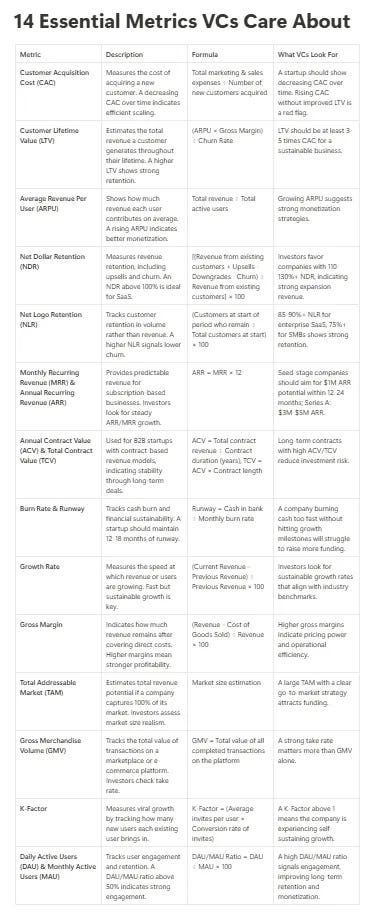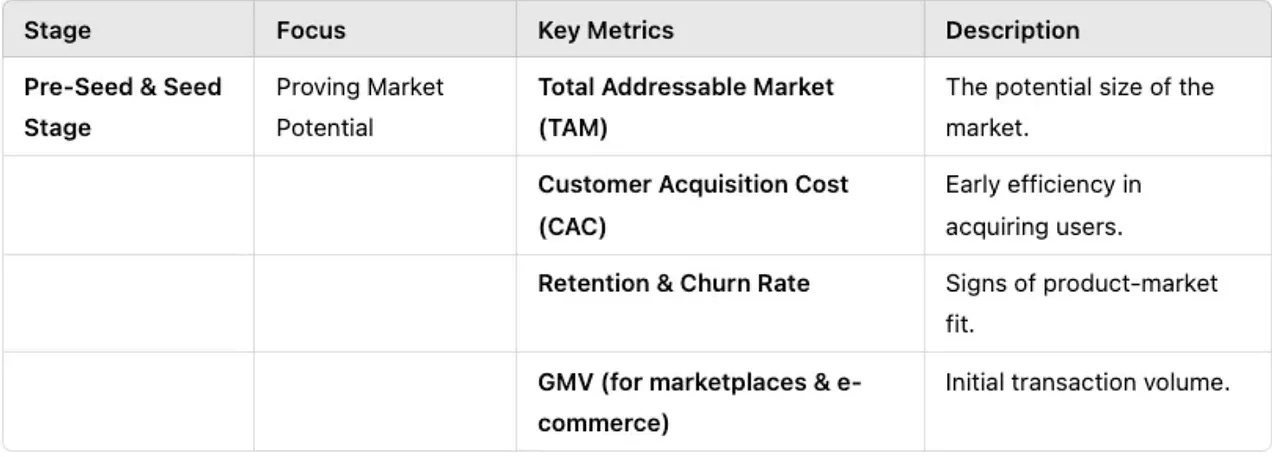🔑 Key Startup Metrics VCs Care About: How to Track, Improve & Use Them to Raise Capital
Learn the key metrics investors actually care about—and how founders can improve them to unlock funding
Here’s a common startup scenario:
A founder walks into a VC pitch meeting with a bold vision and a polished deck. The story is compelling. The opportunity is massive.
But then come the questions:
What’s your CAC? Your LTV? What’s your retention rate?
Suddenly, it’s not about the idea anymore. It’s about the numbers—the key startup metrics that signal whether the business is scalable, investable, and built to last.
If those numbers aren’t dialed in, the pitch ends early. No follow-up. No term sheet.
This guide breaks down the startup metrics VCs care about most—and how you can improve them at any stage to increase your chances of raising capital.
Brought to you by BOXABL 🏠
BOXABL is using assembly-line automation to disrupt the trillion-dollar home construction industry. Their patented tech builds fully-equipped homes in just four hours (compared to seven months traditionally).
They've reserved Nasdaq* ticker BXBL are raising funds on StartEngine and the round is closing on 3/29. Learn how to join 40k+ investors already backing them.

This happens all the time.
VCs love a great story—but without strong startup metrics to back it up, even the best vision won’t get funded.
Venture capitalists rely on key metrics to assess whether a startup is scalable, efficient, and built for long-term success. Numbers like Customer Acquisition Cost (CAC), Lifetime Value (LTV), and Annual Recurring Revenue (ARR) reveal what’s really happening under the hood.
If you're raising capital, understanding which VC metrics matter most, and how to improve your metrics, can be the difference between a yes and a pass.
Let’s break down the key metrics investors care about, how they vary by stage, and how to optimize them to increase your chances of fundraising success.
Table of Contents
14 Key Startup Metrics VCs Care About
Which Metrics Matter Most at Each Fundraising Stage?
Industry-Specific Metrics That Matter
Vanity Metrics to Avoid
What If You’re Pre-Traction?
How to Improve Your Startup’s Metrics
Strong Metrics Are Everything
1. 14 Key Startup Metrics VCs Care About
Let’s be clear: investors don’t fund ideas—they fund metrics. Every number tells a story about how efficient, scalable, and investable your business is.
If you’re fundraising, these key startup metrics are what VCs look for before writing a check.

Below is a breakdown of the most critical metrics, how they’re calculated, and what investors look for.
1. Customer Acquisition Cost (CAC)
What it is: How much it costs to acquire a new customer.
Formula:
Total marketing & sales spend ÷ Number of new customers acquired
Benchmarks:
SaaS: 1:3 CAC-to-LTV ratio
E-commerce: 1:5 is strong
Why VCs care:
A high CAC signals inefficiency. Investors want to see decreasing CAC over time. If it’s increasing, and LTV isn't keeping up, it’s a red flag.
2. Customer Lifetime Value (LTV)
What it is: The total revenue a customer generates over their lifecycle.
Formula:
(ARPU × Gross Margin) ÷ Churn Rate
Benchmarks:
SaaS: 3–5× CAC
B2C: 4–6× CAC
Why VCs care:
If LTV < CAC, you’re losing money acquiring customers. Investors want to see a growing LTV over time.
3. Average Revenue Per User (ARPU)
What it is: Measures monetization efficiency.
Formula:
Total revenue ÷ Total active users
Why VCs care:
A rising ARPU means your monetization strategy is working. VCs track this to see if your pricing and product value are aligned.
4. Net Dollar Retention (NDR) – Revenue Expansion Over Time
What it is: How much revenue you keep—and grow—from existing customers.
Formula:
[(Starting revenue + Upsells – Downgrades – Churn) ÷ Starting revenue] × 100
Benchmarks:
SaaS: 110–130%+ is best-in-class
<100% = shrinking revenue base
Why VCs care:
High NDR shows your existing customers are expanding. It’s more efficient than constantly acquiring new ones.
5. Net Logo Retention (NLR)
What it is: The percentage of customers you retain over time.
Formula:
(Customers retained ÷ Customers at start of period) × 100
Benchmarks:
85–90% for enterprise SaaS
75%+ for SMBs
Why VCs care:
NLR reveals customer satisfaction and product stickiness. Losing too many customers? Scaling becomes much harder.
6. Monthly Recurring Revenue (MRR) & Annual Recurring Revenue (ARR)
What it is: Predictable revenue streams for subscription-based startups.
Formula:
ARR = MRR × 12
Benchmarks:
Seed: $1M ARR within 12–24 months
Series A: $3M–$5M ARR
Series B+: $10M+ ARR
Why VCs care:
MRR and ARR are core SaaS metrics that reflect revenue stability. A consistently rising ARR shows retention, product-market fit, and healthy churn control.
7. Annual Contract Value (ACV) & Total Contract Value (TCV)
What it is: Measures contract revenue for startups with longer sales cycles (e.g., enterprise SaaS, defense tech).
Formulas:
ACV = Total contract value ÷ Contract length (years)
TCV = ACV × Contract term
Why VCs care:
High ACV and long-term contracts reduce revenue volatility. They signal strong customer relationships and dependable cash flow.
8. Burn Rate & Runway
What it is: Burn rate tracks monthly spend; runway measures how long you can operate before needing more funding.
Formula:
Runway = Cash in bank ÷ Monthly burn rate
Benchmarks:
Maintain 12–18 months of runway
Why VCs care:
Burning too fast without hitting milestones is a red flag. Runway = survival. Smart founders plan ahead and stay lean while growing.
9. Growth Rate
What it is: Measures how fast revenue or user base is growing.
Formula:
(This period’s revenue – Last period’s revenue) ÷ Last period’s revenue × 100
Benchmarks:
Seed: 15–20% MoM
Series A: 8–12% MoM
Series B+: 100%+ YoY
Why VCs care:
Growth is non-negotiable. But it must be sustainable. Flatlining early signals poor retention or limited market demand.
10. Gross Margin
What it is: The % of revenue left after direct costs (COGS).
Formula:
(Revenue – COGS) ÷ Revenue × 100
Benchmarks:
SaaS: 70–80%
E-commerce: 40–50%
Why VCs care:
Margins = efficiency. Strong gross margins mean your business has pricing power and room to invest in growth.
11. Total Addressable Market (TAM) – Market Opportunity
What it is: The total potential revenue opportunity if your startup captured 100% of its market.
Why VCs care:
A billion-dollar market is key to justifying a billion-dollar valuation. VCs also consider SAM and SOM to estimate realistic market share.
12. Gross Merchandise Volume (GMV) – For Marketplaces and E-Commerce
What it is: Total value of transactions on your platform.
Formula:
GMV = Number of transactions × Average order value (AOV)
Benchmarks:
Pre-seed: $1M+
Seed: $5M+
Series A: $15M+
Series B+: $50M+
Why VCs care:
GMV is impressive—but only if revenue follows. Marketplaces with a strong take rate (e.g., 10–20%) win here.
13. K-Factor – Measuring Viral Growth
K-Factor measures how many new users an existing user brings in, critical for network-driven businesses like social platforms and marketplaces.
Formula:
K-Factor = (Average invites per user × Conversion rate of invites)
What VCs Look For:
A K-Factor above 1 means the company is experiencing organic, self-sustaining growth.
14. Daily Active Users (DAU) & Monthly Active Users (MAU) – Measuring Engagement
What it is: Tracks how many users actually use your product.
Formula:
DAU/MAU Ratio = DAU ÷ MAU × 100
Benchmarks:
50%+ = strong retention
<20% = potential churn issues
Why VCs care:
High engagement = sticky product. The DAU/MAU ratio is one of the best leading indicators of long-term retention and monetization.
Get the full breakdown + benchmarks here: 14 Essential Metrics VCs Care About

2. Which Metrics Matter Most for Each Fundraising Stage
Not all metrics carry the same weight at every stage of fundraising. Early-stage investors focus on potential and product-market fit, while later-stage VCs prioritize scalability, efficiency, and financial performance.
Pre-Seed & Seed Stage: Proving Market Potential
At this stage, investors look for early signs of traction and a scalable opportunity. Key metrics include:
Total Addressable Market (TAM)
Customer Acquisition Cost (CAC)
Retention & Churn Rate
GMV (for marketplaces & e-commerce)
Series A: Sustainable Growth
With a validated product, investors now expect scalable growth. Key metrics include:
Annual Recurring Revenue (ARR)
Net Dollar Retention (NDR)
CAC Payback Period

Series B+: Scaling Efficiently
Later-stage VCs focus on profitability and efficiency. Key metrics include:
Burn Rate & Runway
Gross Margin
Revenue Growth Rate

Tracking the right metrics at the right time increases the chances of securing investment and scaling successfully.
3. Industry-Specific Metrics
Not all startup metrics are created equal. What matters to a B2B SaaS company may be irrelevant to a consumer app or a fintech platform. VCs adjust expectations depending on your industry, business model, and stage of growth.
Here’s how VC metrics differ by vertical:
SaaS & Subscription Startups
Predictable revenue is everything. That’s why ARR, MRR, and NDR are top priorities.
ARR / MRR: Tracks recurring revenue growth
NDR (Net Dollar Retention): 110%+ = healthy expansion
CAC Payback Period: Under 12 months = scalable unit economics
💡 VCs love SaaS companies that can grow revenue from existing customers while keeping acquisition costs lean.
E-Commerce & Marketplaces
Volume and margins drive success here.
GMV (Gross Merchandise Volume): Total value of transactions
Take Rate: % of GMV converted into platform revenue (the higher, the better)
AOV (Average Order Value): Bigger baskets = better profitability
VCs also look at repeat purchase rates and contribution margins to evaluate long-term viability.
Consumer Apps & Social Platforms
User engagement and virality matter more than pure revenue in the early days.
DAU / MAU Ratio: 50%+ = strong user retention
K-Factor: >1 means self-sustaining viral growth
Session Length / Frequency: Signals user stickiness
💬 VCs want to see network effects, rapid user growth, and product-led retention.
Fintech & Payments
Investors care about scale, efficiency, and regulatory readiness.
Transaction Volume: Total $$ processed via your platform
Take Rate: Shows how much of that turns into revenue
Compliance Metrics: AML, KYC, fraud risk, etc.
🔍 VCs scrutinize risk management and legal infrastructure. Compliance issues are deal-breakers.
4. 🚫 Vanity Metrics to Avoid in Your Pitch
Some numbers look impressive on a pitch deck—but fall apart under scrutiny. These are vanity metrics: metrics that sound good but don’t reflect real performance or growth.
Investors can spot them instantly. If your metrics don’t tie back to revenue, retention, or scalability, they’re likely just noise.
Here are 4 common vanity metrics that trigger investor red flags:
❌ Total Users vs. Active Users
Boasting millions of signups means nothing if users aren’t engaged.
✅ What VCs want:
DAU / MAU
DAU/MAU ratio (50%+ = healthy retention)
❌ Followers & Website Traffic
A strong social presence or viral spike is great—but it’s not a business model.
✅ What VCs care about:
Conversion rate
Customer Acquisition Cost (CAC)
Engagement & retention metrics
❌ Downloads Without Retention
100K downloads? Impressive. But if users churn after Day 1, it’s a red flag.
✅ What VCs measure:
Net Dollar Retention (NDR)
Churn rate
Activation metrics
❌ Revenue Without Profitability
Top-line growth is only part of the picture. If your burn is outpacing your revenue, that’s not growth—it’s risk.
✅ What VCs analyze:
Gross Margin
Burn Rate
CAC Payback Period
🎯 The Bottom Line
Vanity metrics make headlines, but real KPIs raise money.
Focus on metrics investors care about—the ones that prove you’re building something scalable, efficient, and built to last.
5. What If You’re Pre-Traction?
Venture capital isn’t just about revenue but proving that your startup has a scalable, repeatable growth model. But even though you don’t have strong financial metrics yet, investors still look for signals that indicate potential, even before traction fully materializes.
Focus on Market Potential & Team Strength
When startups lack revenue or user growth, investors shift their attention to:
Total Addressable Market (TAM) – Is the market large enough for a billion-dollar outcome?
Team Strength – Have the founders successfully built or scaled companies before?
Competitive Differentiation – What makes your solution unique and hard to replicate?
At pre-seed and seed stages, these qualitative factors weigh as much as, if not more than, hard numbers.
Highlight Leading Indicators of Success
Even without ARR or MRR, investors look for leading indicators of success that signal potential traction. A growing waitlist suggests strong early demand and product-market fit. Engagement data, such as high retention rates or deep user interactions, demonstrates that customers find value in the product.
Additionally, early customer feedback, including positive testimonials or a willingness to pay, validates that the solution addresses a real need. These qualitative signals help investors gauge whether a startup is on the path to meaningful growth, even before revenue materializes.
Storytelling Matters More Than Ever
Without strong revenue metrics, your narrative is your biggest asset. Founders must frame their traction (or lack thereof) within a compelling vision. Position small wins as momentum. A single enterprise contract or a viral user response can be a powerful signal. Showcase partnerships – strategic relationships can indicate credibility. Investors fund potential. If you lack hard metrics, make sure you’re telling a story that convinces them your startup is the next big thing.
6. How to Improve Your Metrics & Impress VCs
Strong startup metrics don’t happen by accident. They’re the result of intentional strategy, consistent experimentation, and operational discipline.
If you want to raise capital, focus on three core pillars:
✅ Efficiency
✅ Retention
✅ Sustainable growth
Here’s how to improve the VC metrics that matter most:
💰 Lower Your CAC (Customer Acquisition Cost)
You can’t scale if it costs too much to acquire a customer.
Tactics to lower CAC:
Double down on high-performing paid channels
Improve conversion rates on landing pages and onboarding
Build organic loops: SEO, referrals, communities
Shorten the buyer journey with clearer CTAs and pricing
💰 Boost LTV (Lifetime Value)
Want to grow revenue without constantly acquiring new users? Increase how much each one spends.
Ways to increase LTV:
Upsells and cross-sells
Premium features or pricing tiers
Improve product stickiness (think: notifications, habit loops)
Proactively fight churn through support and feedback loops
💰 Shorten CAC Payback Period
Getting your money back faster is key to scaling without constantly fundraising.
Optimize for faster CAC payback by:
Lowering onboarding friction (e.g., freemium, trials)
Raising ARPU through bundling or upsells
Tightening margins—negotiate vendor costs, automate ops
Prioritize high-LTV segments and accounts
💰 Improve Retention & NDR
Retention is the silent killer of startups. Without it, growth is just a leaky bucket.
To improve retention and NDR:
Onboard new users effectively (first 5 minutes = everything)
Use personalization based on user data
Bake in expansion revenue: premium plans, usage-based pricing
Incentivize referrals—nothing scales like word of mouth
Nothing scales better than word-of-mouth.
💰 Extend Runway & Lower Burn Rate
Runway gives you time. Without it, even the best startups fail.
Ways to extend runway wisely:
Cut what’s not working (tools, agencies, features)
Focus spend on channels with measurable ROI
Automate low-impact tasks
Hire smart: fewer people, higher leverage
🔁 Final Thoughts: Why Metrics Matter Most to Investors
Investors fund traction, not just vision.
By tracking and improving key startup metrics like CAC, LTV, ARR, gross margin, and NDR, founders can build a credible, fundable business.
At every stage, the metrics change—but the importance of data doesn’t.
Great metrics don’t just unlock capital. They drive sustainable success.





